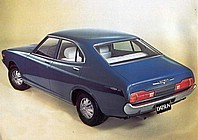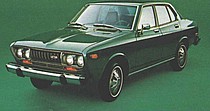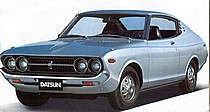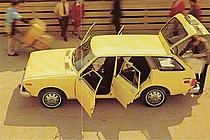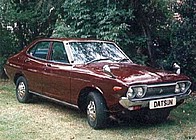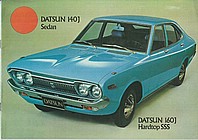
The sporty SSS model has rear independent suspension, others have a leaf sprung rear. Aside from the different name, the North American market 710 received large separate bumpers rather than the curved, fitted pieces used in other markets to comply with United States bumper legislation in 1973. Early export market cars were fitted with tiny chrome cover plates to hide the holes left on top of the front fenders by the Japanese market rear view mirrors. The most powerful version offered in Japan was the fuel injected 1600 SSS-E with 110 PS (81 kW) JIS at 6200 rpm. In export markets the twin-carb 160J SSS claimed 95 PS (70 kW) DIN, five more than the regular 160J. In Japan, the 1800 cc engine arrived in October 1975 and was only available running on LPG, for taxi use.
Datsun Violet GL fastback sedan (710, Japan)
This vehicle was available for sale around the same time as the first generation Toyota Carina. The original four-door bodywork was quite swoopy, with a fastback line. It was one of the first Nissan products to introduce “coke bottle styling”, an appearance that had debuted internationally during the 1960s and 1970s. Its appearance was controversial, which led to a certain amount of customer complaints at the limited rear vision and dark rear cabin – especially for children. Taxi companies refused to purchase any more Violets, and in a rather drastic facelift gradually introduced beginning in February 1976
North America
The North American-spec Datsun 710 Station Wagon
In the United States and Canada, the car was sold simply as the “Datsun 710”. Two- or four-door sedans, a two-door coupé, and a five-door station wagon were available. All received the 2-liter L20B engine, with 97 or 94 hp (72 or 70 kW) (SAE Net) in 49-state and Canadian trim versus California-spec cars. The federal/Canadian version took leaded fuel and depended on an EGR system for pollution control, while the California cars have a catalytic converter and require unleaded gasoline. Gross horsepower ratings are 110 and 107 respectively. Mysteriously, while wagons usually have a smaller gas tank of 11.9 US gal (45.05 L) rather than 13.2 US gal (49.97 L), the California-market 710 wagon has the same size gas tank as the sedans and hardtops.
Introduced for the 1974 model year, the 710 only saw very light modifications for 1975. The steering was adjusted to decrease driver effort, while noise levels were reduced, and gear ratios were adjusted to boost gas mileage. Externally, the bumper overriders received a slight chrome molding in the middle.
Taiwan
In Taiwan the Violet was introduced in 1973 under the name Yue Loong Violet and replaced the successful Datsun Bluebird there for nine years. The Yue Loong Violet was usually offered with the OHV J16 engine. The VIP Brougham was a luxury version of the Violet with leather seats and wood interior. Official successor was the Yue Loong Elite 601 which was a sister model to the Nissan 200SX.
Mexico
For the Mexican domestic car market, the 710-series Violet was produced from 1973 to 1978 at Nissan’s CIVAC assembly plant, near Cuernavaca, Mexico. At the time, Nissan Mexico offered a unique passenger-vehicles lineup, the Datsun Bluebird range (the 510-series and the 410, previously), integrated only by the 4-door saloon and Wagon versions of the Bluebird, respectively commercialized as the Datsun Sedan and Datsun Guayín (Guayín is a moniker in Mexican spanish for “Station Wagon”). In 1974, going on with the same business strategy, the 710-series Violet was introduced to the Mexican car market badged as the new Datsun 160J, the replacement for the single-offered Bluebird lineup.
The Mexican 710 Violet range was integrated only by the 4-door Saloon alongside the Wagon, lacking the sporty 2-door/coupe bodies offered in some other countries. The fastback-styled 710 4-door saloon design was marketed from 1974 to 1977, being replaced in 1978 with the notchback-styled 711 Violet (which intended to improve the fastback’s bad rear visibility complained by some customers). All Mexican 710 Violets featured the 1.6-liter carbureted engine (160J), coupled to a 4-speed manual gearbox, and an optional 3-speed automatic gearbox starting in 1978.
For 1979, the 710 range was superseded by the correspondent next generation A10-series Violet in the Nissan Mexico lineup.
New Zealand
New Zealand, as a result of the government’s temporary lift of import licensing restrictions (the result of high consumer demand for cars, which local CKD assemblers and built-up importers could not meet with the usual licensing restrictions and high import duties of up to 55%, plus sales tax up to 60%) saw considerable CBU imports of the Datsun 140J four-door sedan and 160J two-door during 1973 and 1974.
Due to the short notice and short timeframe of the licence requirement relaxation, the cars imported differed slightly in specification from shipment to shipment – some had Japanese market amber front park lights, front guard-mounted exterior rear view mirrors and ‘Violet’ badges; later units had clear lenses and 140J/160J badging.
Several hundred 140J sedans entered New Zealand through the Port of Timaru for the South Island market and all were presold before they arrived. All were keenly sought-after and hard to secure as they were better specified as standard (tinted glass, AM pushbutton radio, etc.) than the NZ-assembled CKD kit imported models, which consisted of the Datsun 1200 sedan and wagon, and 180B (Bluebird) and 260C (Cedric) sedans.
Almost-new 140Js were often resold soon after first registration for hundreds of dollars more than their retail prices, such was the model line’s initial popularity. The Japanese assembly quality of the 140J was better than the NZ-built Datsuns of the time which were assembled by outside assembly contractors – Nissan themselves did not open its own ‘temporary’ plant in Mt Roskill, Auckland, until the mid-1970s and a dedicated, purpose-built factory in Wiri in 1978.
South Africa
In South Africa, the 1976 “711” facelift arrived in October 1976 and continued in production for a while longer than in Japan. It was sold as the Datsun 160U or 180U, depending on engine fitment. Deluxe and SSS sedans as well as an SSS Hardtop were available. A batch of 100 SSS models (some of which were Bluebirds) with special “Mexican” upholstery was also built in 1978.
Overview
Chassis Code 710
Manufacturer Nissan
Also called Datsun 140J/160J, Datsun 160U/180U (South Africa), Datsun 710, Datsun Sedan/Guayín, Yue Loong Violet (Yulon, TW)
Production Japan: 1973–1977, Taiwan: 1973–1979, Mexico: 1974–1978
Body and chassis
Body style
2-door hardtop coupe
2/4-door fastback sedan
4-door notchback sedan
5-door estate/van
Layout
Front-engine, rear-wheel-drive
Powertrain
Engine
1.4 L L14 I4 OHC (In Line 4 Cylinder) (710/711)
1.6 L L16/L16E/L16P I4 OHC (In Line 4 Cylinder) (P710/711)
1.8 L L18/L18P I4 OHC (In Line 4 Cylinder) (R710)
2.0 L L20B I4 OHC (In Line 4 Cylinder) (H710/WH710, export only)
Transmission
4/5-speed manual
3-speed automatic
Dimensions
Wheelbase2,450 mm (96 in)
Length 4,120 mm (162 in)
Width 1,580 mm (62 in)
Height 1,375 mm (54.1 in)
Curb weight 1,005 kg (2,216 lb)
